The secrets of a successful digital CX strategy
It's no surprise that marketing's role in business-to-business is evolving, frequently faster than we'd like. For marketing leaders, a critical piece of any successful strategy for keeping up with that evolution is the quality of the customer experience their brands deliver.
That was the key lesson of our recent webinar, " Perspectives from Sirius Decisions & Crownpeak: Successful Digital CX Strategy ," where Cheri Keith, Principal Analyst at Forrester/SiriusDecisions joined me to explore the challenges facing marketers as they try to draft a navigable roadmap for their digital marketing and digital transformation initiatives.
A top priority, but with hurdles ahead
As Cheri explained, SiriusDecision's research shows that customer experience is the number one priority influencing CMOs strategy over the next two years. "This is a shift," she pointed out, with several factors driving a change in focus of senior marketing leadership.
First, SaaS solutions have driven a digital transformation of business models. The new reality of continuous revenue streams has changed marketing's role with an increasing emphasis on bookings, renewals and lifetime value. In turn, CMOs have rebalanced their priorities, as the breadth of the journey they support and the number of touchpoints that need to be managed have grown and become more complex. Finally, there's been an evolution in marketing's overall role in B2B, as it increasingly coordinates across functions and cannot simply focus on getting prospects engaged at the top of the Demand Waterfall .
When customer experience becomes this important, putting strategy ahead of technology is critical – dictating martech adoption where "flexibility and extensibility" is key and not just bells and whistles. Systems must integrate seamlessly and deliver value as part of a holistic digital marketing stack capable of supporting a superior end-to-end, omnichannel customer experience.
Cheri told us that there are common challenges for enterprises striving to deliver that level of CX. A little over 14% of CMOs surveyed felt their top challenge was how ready their organizations were to deliver digital CX; others felt the top obstacles they faced involved not having the right technology on hand, insufficient data, or a lack of insights about their customers.
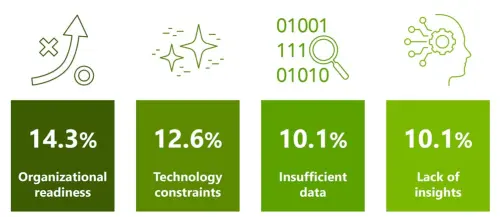
This doesn't always mean there's a lack of adequate technology, Cheri said. A company may realize "we might have to be using our (existing) technology in different ways to catch up." The same might go for data: marketers might not realize the data they already have on hand, and/or lack the tools for mining it for customer insights, possibly due to limitations of legacy infrastructure.
Companies that take a phased approach to overcoming these hurdles, and to digital transformation in general, are the ones we've seen having the most success. "Taking bite-sized pieces," as I like to say: Demonstrating the value of a solution in order to pave the way for the next adoption, getting the organization and IT aligned behind a budget and a technology roadmap in an iterative way that's more manageable than tackling everything at once.
Evolving toward digital maturity
The SiriusDecisions survey revealed that a significant number of organizations are making investments in digital transformation, including in analytics, website optimization, web content management, and website analytics.
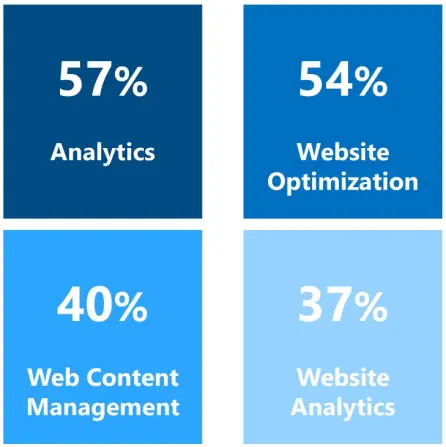
The fundamentals of marketing have never changed: understand your audiences' needs and deliver compelling messages and experiences. That's equally true online. That focus helps guide what investments a company makes in order to optimize CX, rather than simply make technology investments without having their "eye on the prize."
In pursuit of that, a company typically graduates through three levels of digital maturity when it comes to its marketing efforts. Reaching the fully mature end of the digital transformation spectrum doesn't have to be a monumental task if you follow a phased approach of quick, agile deliverables that each show solid ROI and therefore earn the next step's budget and project approvals.
- At the tactical level, digital transformation efforts are siloed, with little measurement beyond the immediate results of a tactic and no insight into how it impacts the overall business.
- At the programmatic level, there's limited planning with non-digital marketing stakeholders and some cross-functional coordination, and some glimpses afforded into how a digital program may have affected the business as a whole.
- The fully mature strategic digital marketing model ("the nirvana that we're all looking for," as Cheri remarked) is where everyone thinks in terms of fully integrated campaigns, where digital and non-digital work in harmony, and they're mutually focused on various business goals, including digital transformation.
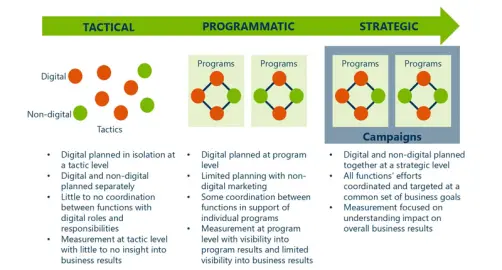
What type of digital organization are you?
Aligning digital marketing strategies with your digital transformation goals means first understanding the nature of your offering, go-to-market approach, and the purchase complexity process. These three factors determine what type of digital marketing organization you truly are.
A digital-first organization typically offers a relatively simple product at a low price, so digital can provide all the marketing reach, scale, and cost-effectiveness needed to succeed. Cheri's example was for a company marketing blade servers, which are built to standard and involve little competitive differentiation, don't rely on direct sales, and are at a relatively low price point.
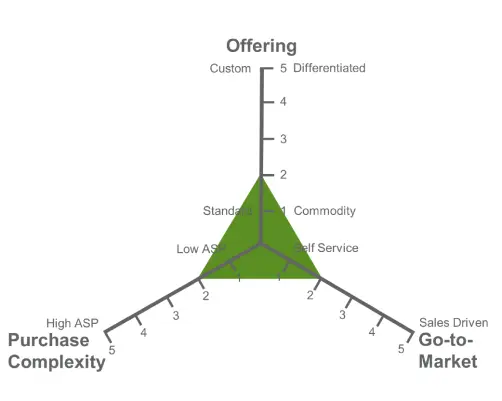
Digital Support organizations usually offer complex and more expensive products with protracted buyer journeys and consideration cycles; Cheri's example was a manufacturer of corporate private jets, where the product is highly differentiated through customization, the cost is steep, the buy cycle is lengthy, and sales rely on a network of in-house or partner reps. The role of digital marketing is in generating and nurturing leads and accelerating qualified opportunities.

In either case, digital marketing plays a key role, but one that has to be driven by the company, its products, its markets, and other factors. There's no one-size-fits-all template in digital marketing, in other words.
There are, naturally, a lot of possible hybrid models depending on where your company or product falls along the three parameters we discussed.

The power of personas
As SiriusDecisions sees it, buyer and stakeholder personas are at the core of any audience-centric digital transformation strategy, since they provide the context for everything from technology to channel to decisions about your content mix.
When a persona is built it has to go far beyond just job title (the "Director of Digital Marketing" might have entirely different responsibilities at two different companies, for instance). There are several areas you should drill down into that are among the most important to digital transformation and engagement, including content preferences, tactic preferences, what enablement tools they use in making decisions, and where they go to share and learn information. They're also among the least-addressed, unfortunately, even though they're essential in today's dynamic digital marketing landscape.
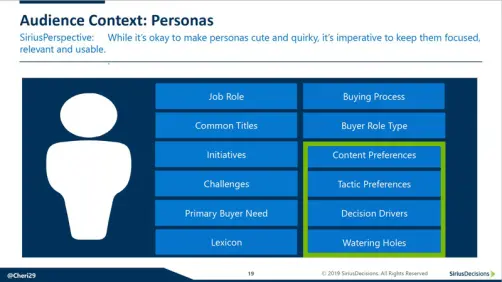
Another common error, as Cheri pointed out, is the failure to keep personas constantly updated, which may owe to marketers thinking it involves the same huge amount of effort it took to research and draft them in the first place. That doesn't have to be the case if you simply commit to making small, iterative adjustments to your personas on a regular basis.
The buyer's journey: human versus digital "touches"
When it comes to the buyer's journey , in a digital-first journey, over 65% of the touchpoints are digital. Salespeople may be involved, but only at a couple key points in the process.
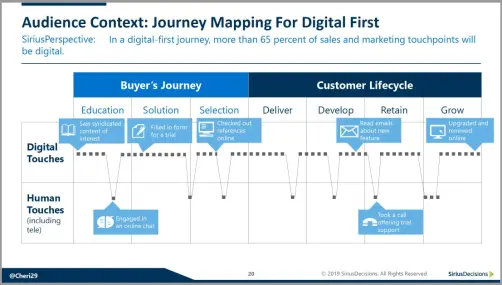
In the digital support journey, it's almost the opposite, as less than 35% of the contact is digital, though they're important touchpoints. If you're selling a corporate Gulfstream, there's not yet a digital substitute for glad-handing executives at a luxury golf outing.
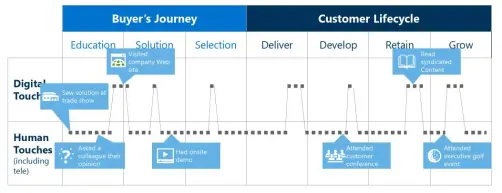
Where you can clearly see the importance of understanding your personas and your digital style is in the way it impacts each CX journey, and digital transformation overall. Take a look at these visualizations of journeys that are customized and targeted based on the prospects persona.
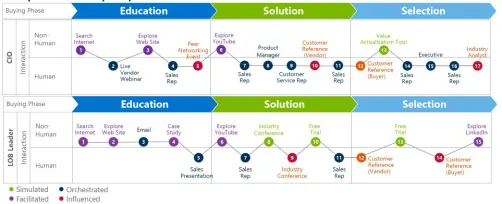
This visualization helps you identify where digital touches can dramatically impact the quality of the customer experience and potentially deliver outsized value back to the bottom line.
This doesn't mean you have to address all of this at once. Follow the principle of iterative improvement by using data to identify the "low-hanging fruit," or the digital touchpoints where you've got the best opportunity to test and validate an engagement tactic. That's part of a customer-centric and highly agile approach that'll accelerate the process of optimizing CX and demonstrate rapid time-to-value for your organization.
Explore all of the insights Cheri and I delved into during the webinar and its Q&A with attendees by watching it here .